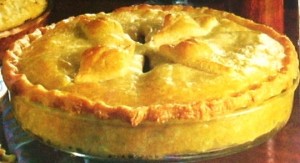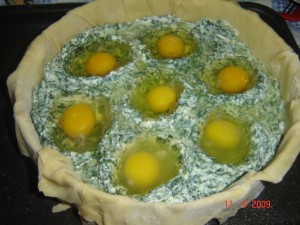Torta pasqualina, curiosità e tradizioni di questo storico piatto ligureTorta Pasqualina, curiosity and traditions of this historic Ligurian dish
Ingredienti, storie e tradizioni di questo piatto tipico ligure a base di verdura che si usava mangiare nel periodo di Pasqua
“La razza dei genovesi è come quella dei pellerossa, si sta spegnendo poco a poco. È un peccato per il mondo, cui abbiamo regalato due cose grandi come l’America e la torta Pasqualina”. Così scriveva il giornalista Giovanni Ansaldo nel 1930. L’origine di questo piatto tipico si perde nella notte dei tempi e la paternità è contesa. Ma i liguri possono vantare di avere dalla loro parte un documento del 1500 di Ortensio Lando, che cita la pasqualina genovese nel “Catalogo delli inventori delle cose che si mangiano et si bevano”, apprezzandola a tal punto da scrivere: “A me piacque più che dell’orso il miele”.

Vista da vicino
La pasqualina è una torta salata tipica della zona di Genova: è cotta al forno e ripiena di verdure, uova e formaggio. Oggi, il suo sapore ha superato i confini della Superba ed è ben conosciuto da ogni palato ligure (e non solo). Il nome spiega già l’occasione e il momento in cui, tradizionalmente, si preparava. In genere, infatti, veniva utilizzata come portata principale del menù di Pasqua. Ma tante sono le tradizioni legate a questo piatto, vediamo qualche esempio.
• La torta pasqualina è ancor più buona se consumata fredda, il giorno dopo averla preparata. Ecco perché, nel tempo, è diventata l’alimento simbolo non solo di Pasqua, ma anche di Pasquetta. Viene infatti utilizzata come pietanza per i pic nic e le gite fuori porta che si fanno il lunedì dell’Angelo.
• Gli ingredienti variano a seconda delle stagioni: oltre alle uova e al formaggio, si usano le erbette, i piselli, le cipolline e i carciofi (meglio se quelli di Albenga); ma anche le borragini, le bietole e gli spinaci.
• Nella pasqualina originale non possono poi mancare: la maggiorana e la prescinsêua, tipico formaggio ligure cagliato, molto difficile da reperire fuori da questa Regione.
• La sfoglia: la tradizione vuole che se ne facessero ben 33 strati, come gli anni di Cristo, e tutti sottilissimi. Negli anni, a causa della mancanza di tempo, il loro numero è diminuito. Anche il tipo di pasta è particolare: è preparata con acqua, farina e olio di oliva, ma senza lievito.
• La torta ripiena, secondo la tradizione, deve essere coperta: la sfoglia inferiore deve superare i bordi della teglia, in modo da formare con quella di sopra una bella crosta arricciata decorativa.
• In passato, date le dimensioni, non bastava il forno di casa per cuocere questa pietanza. Per questo, le cuoche incidevano sulla pasta le cifre della propria famiglia. Così, quando l’andavano a ritirare dai panettieri non le confondevano con le altre.
Consigli della nonna
Il giorno prima di quando si vuole preparare la torta, si lavano per bene le verdure, si eliminano i gambi, e si tagliano in striscioline molto sottili le foglie. Poi si mettono in un panno e si attende tutta la notte che rilascino la loro acqua. Alcuni, poi, lessano le erbette in acqua bollente o le fanno saltare in padella insieme ai carciofi e a un soffritto di cipolla. Altri, invece, le lasciano crude nell’impasto e le cuociono direttamente in forno.
Crude o cotte, le verdure si aggiungono al ripieno di formaggio grattugiato,uova sbattute, sale e maggiorana fresca. Si versa poi il composto nella tortiera e sopra si sparge la prescinsêua.
Con un cucchiaio si creano alcuni cunei e lì si fanno cadere delle uova intere, che durante la cottura diventeranno sode. Si chiude tutto con la sfoglia e si cuoce da 45 minuti fino anche a un’ora, a seconda delle dimensioni della torta.
Fonte: lacucinaitaliana.it
PER LA PASTA
1 Kg. di farina bianca
4 cucchiaiate d’olio
sale, e acqua quanto basta.
PER IL RIPIENO
1 kg. di erbette (oppure 10 cuori di carciofo)
1/2 cipolla tritata
60 grammi di burro
500 grammi di prescinseua (sostituibile con ricotta allungata con un goccio di latte)
6 uova
1 bicchiere di latte
100 grammi di parmigiano grattuggiato
sale, pepe e maggiorana.
Impastare la farina con l’olio, il sale e tanta acqua quanto basta per ottenere una pastadi giusta consistenza. Lavoratela molto bene e dividetela in 10 pallottoline (anticamente se ne facevano fino a 33), copritele con un tovagliolo umido e sopra uno asciutto e lasciatele riposare per un quarto d’ora. Intanto lessate le erbette (o i carciofi) e insaporiteli con il soffritto di cipolla e olio. Lavorate la ricotta con il latte e unite un pizzico di sale.
Tirate 10 sfoglie sottilissime con la pasta e stendete la prima su una tortiera unta e infarinata. Spennellatela con un poco d’olio e ritagliate con un coltello il cordone di pasta che cresce dalla tortiera. Stendete altre cinque sfoglie, spennellandole sempre con l’olio, poi fate uno strato con le verdure e uno con il formaggio.
Preparate sul formaggio 6 fossette e mettete in ognuna un pezzetto di burro, rompendoci dentro un uovo, condite con un pizzico di sale, di pepe e di maggiorana e il parmigiano.
Coprite con le rimanenti sfoglie spennellandole con l’olio. Punzecchiate con una forchetta l’ultima sfoglia, ungetela bene e ritagliare il cordone di pasta che cresce dalla tortiera.
Passate in forno a calore moderato (sarebbe meglio il forno del pane) per circa 60 minuti.
La torta pasqualina deve prendere un bel colore biondo.
La si può servire, a seconda dei gusti, tiepida o fredda.
Trucco: se volete potete utilizzare, con buoni risultati, anche la pasta sfoglia già pronta, ma non ditelo in giro!Ingredients, history and traditions of this typical Ligurian dish of vegetables that they used to eat at Easter
“The race of Genoese is like that of the redskin, it is dying little by little. It is a pity for the world, which we gave away two great things as America and Pasqualina cake. ” So he wrote the journalist Giovanni Ansaldo in 1930. The origin of this dish is lost in the mists of time and the authorship is disputed. But the Ligurian can boast of having on their side a document of 1500 from Hortensius Lando, citing Genovese pasqualina in the “Catalogue of the inventors of things you eat and you drink”, appreciating it so much to write: “I liked that most then the bear the honey”.

Close up view
Pasqualina is a typical pie of the Genoa area: it is baked and stuffed with vegetables, eggs and cheese. Today, its flavor has exceeded the boundaries of the Superb and is well known by every Ligurian palate (and beyond). The name already explains the occasion and the time when, traditionally, was preparing. Generally, in fact, it was used as a main course of the Easter menu. But there are many traditions associated with this dish, we see some examples.
• The pasqualina cake is even better if eaten cold, the day after it is prepared. That’s why, over time, has become the symbol of food not only of Easter, but of Easter Monday also. It is in fact used as a dish for picnics and outings that are done on the Monday.
• The ingredients vary according to the season: in addition to eggs and cheese, using the herbs, peas, onions and artichokes (preferably those of Albenga); but also borage, chard and spinach.
• In the original pasqualina can not really miss: marjoram and prescinseua, typical Ligurian cheese curds, very difficult to find outside of this region.
• The sheet: tradition has it that he did no less than 33 layers, as the years of Christ, and all extremely thin. Over the years, due to lack of time, their number is reduced. Even the type of pasta is particular: it is prepared with water, flour and olive oil, but without yeast.
• The stuffed pie, according to tradition, must be covered: the lower sheet must exceed the edges of the pan, so as to form with that of over a nice decorative curled crust.
• In the past, due to its size, it was not enough your home oven to cook this dish. For this, the cooks accounted on the sheet the initials of his own family. So, when they went to withdraw from bakers not confused with the other.
Grandma’s tips
The day prior to when you want to prepare the cake, wash the vegetables thoroughly, eliminates the stems, and cut into very thin strips the leaves. Then put them in a cloth and wait all night that would release their water. Some, then, boil the herbs in boiling water or blow up in a pan together with artichokes and a fried onion. Others, however, leave it raw in the dough and the baking directly in the oven. Raw or cooked, the vegetables are added to the stuffing of grated cheese, beaten eggs, salt and fresh marjoram. Then poured the mixture into the cake tin and spreads over the prescinseua. Using a spoon, create some wedges and there dropping of whole eggs, which when cooked become hard boiled. It closes all with the sheet and bake for 45 minutes even up to an hour, depending on the size of the cake.
Source: lacucinaitaliana.it
FOR THE DOUGH
1 Kg. Of white flour
4 tablespoons oil
salt, and water as needed.
FOR THE STUFFING
1 kg. of herbs (or 10 artichoke hearts)
1/2 onion, chopped
60 grams of butter
500 grams of prescinseua (replaceable with cottage cheese added of a dash of milk)
6 eggs
1 glass of milk
100 grams of grated parmesan
salt, pepper and marjoram.
Mix the flour with the oil, salt and enough water to make a paste of right consistency. Knead very well and divide into 10 pellets (once if there were up to 33), cover with a damp towel and let them dry over a stand for fifteen minutes. Meanwhile boil the herbs (or artichokes) and season with the fried onions and oil. Whisk the ricotta with the milk and add a pinch of salt.
Pull 10 thin layers with pasta and roll out the first on a greased and floured cake tin. Brush them with a little oil and cut with a knife the paste cord growing from the pan. Roll out the other five layers, always brushing with oil, then make a layer with vegetables and one with cheese.
Prepare on the cheese 6 dimples and place in each a bit of butter, breaking inside an egg, season with a pinch of salt, pepper and marjoram and Parmesan.
Cover with the remaining layers brushing with oil. Prick with a fork the last sheet, grease it well and cut the cord of pasta that grows from the pan.
Bake in oven at moderate heat (it would be better the bread oven) for about 60 minutes.
Pasqualina cake has to take on a blond color. It can serve, according to taste, warm or cold.
Trick: If you want you can use, with good results, even the puff pastry, but do not tell it all around!







Leave a comment